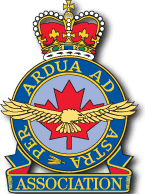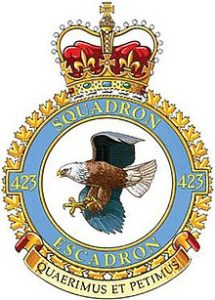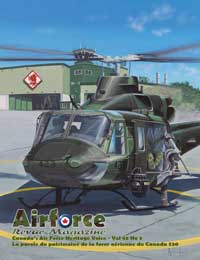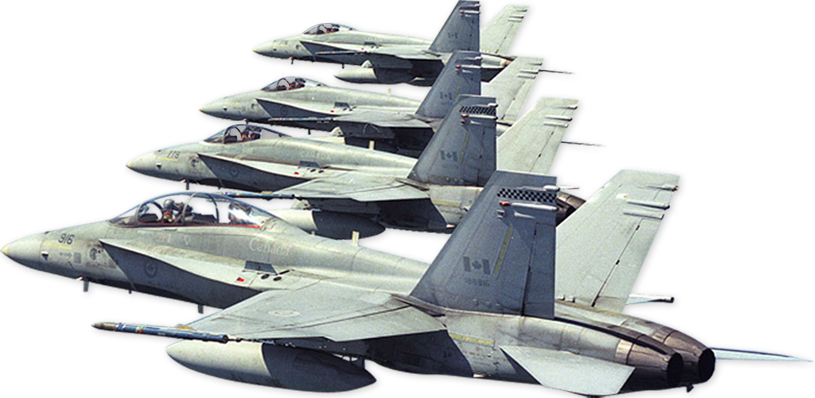 No. 423 Squadron
No. 423 Squadron
Badge: A bald-headed eagle volant
Motto: Quaerimus et petimus (We search and strike)
Authority: King George VI, March 1943
The bald-headed eagle is a powerful bird of prey from the Canadian side of the Atlantic. The motto refers to the squadron’s role as a coastal unit.
Formed as a General Reconnaissance unit at Ohan, Argyll, Scotland on 18 May 1942 as the RCAF’s 21st – sixth and last coastal – squadron formed overseas, the unit flew Sunderland flying boats on convoy escort and anti-submarine patrols over the Atlantic shipping routes. When hostilities ended in Europe, there was a need for more long range transport units to support the proposed ‘Tiger Force” in the Pacific, and the squadron was redesignated Transport on 5 June 1945 and began conversion training to Liberator aircraft. The sudden end of the war in the Far East found the squadron still in the early stages of conversion training and it was disbanded on 4 September 1945.
Brief Chronology: Formed as No. 423 (GR) Sqn, Ohan, Argyll, Scot. 18 May 42. Redesignated No. 423 (T) Sqn, Castle Archdale, Ferm., N. Ire. 5 Jun 45. Disbanded at Bassingbourn, Cambs., Eng. 4 Sep 45.
Commanders
- W/C F.J. Rump (RAF) 18 May 42 -9 Jul 43.
- W/C L.G.G.J. Archambault 10 Jul 43 -16 Jul 44.
- W/C P.J. Grant 17 Jul 44 -28 Feb 45.
- W/C S.R. McMillan 1 Mar 45 -4 Sep 45.
Higher Formations and Squadron Locations
Coastal Command:
No. 15 Group,
- Oban, Argyll, Scot. 18 May 42 -1 Nov 42.
- Castle Archdale, Ferm., N. Ire. 2 Nov 42 -4 Jun 45.
Transport Command:
No. 47 Group,
No. 301 Wing,
- Castle Archdale, Ferm., N. Ire. 5 Jun 45 -7 Aug 45.
- Bassingbourn, Cambs. 8 Aug 45 -4 Sep 45.
Representative Aircraft (Unit Code AB, 3) (1)
Short Sunderland Mk.III (Jul 42 -May 45)
- W6000 A W6001 B W6007 G W6008 H W6009 J W6061 K00849 M 00853 K 00867 G OP181 0 OP198 J OWlll S EJ157 K EK583 J ML783 H ML784 L ML883 F NJ182 N NJ183 G NJ184 C NJ185 E NJ186-A NJ187 B
Consolidated Liberator C.Mk.VI & VII (Aug 45)
Operational History: First Mission 23 August 1942, Sunderland W6053 AB-E from Oban with F/L J. Musgrave and crew -13-hour submarine search.
Victories: U-boat: 12 May 1943, Sunderland W6006 3-G from Castle Archdale with F/L J. Musgrave and crew – escort to Convoy HX.237, shared with 2 destroyers (HMCS Drumheller and HMS Lagan) in sinking U-456 in the Western Approaches at 4837N 2239W. 4 August 1943, Sunderland 00859 3-G from Castle Archdale with F/O A.A. Bishop and crew – sank U-489 in the Western Approaches at 6111N 1438W. Shot down by return fire, five of the eleven-man crew were lost; the other six, all wounded, were rescued by a destroyer along with 23 survivors of the submarine. 8 October 1943, Sunderland 00863 3-J from Castle Archdale with F/O A.H. Russell and crew – escort to Convoy SC.143, sank U-610 in the Western Approaches at 5545N 2433W. 24 April 1944, Sunderland 00862 AB-A from Castle Archdale with F/L F.G. Fellows and crew – sank U-311 at 5036N 1836W. 11 September 1944, Sunderland ML825 AB-O from Castle Archdale with FIO J.N. Farren and crew – joined two of HMC Ships, Dunver and Hespeler, in sinking U-484 at 5651N 0804W.
Last Mission: 31 May 1945, Sunderland ML777 AB-F from Castle Archdale with F/L Magor and crew – patrol to the southwest of Ireland.
Summary Sorties: 1392.
- Operational/Non-operational Flying Hours: 16,27715122.
- Victories: U-boat: 3 sunk, 2 shared sinkings, 1 damaged; 25 actual submarine, periscope or snorkel sightings, 10 of snorkel smoke, 6 disturbances, swirls or suspicious oil slicks; delivered 201 250-pound depth charges in 26 attacks, an average of 1 attack for every 684 operational hours flown.
- Casualties:
- Operational: 6 aircraft; 43 aircrew, of whom 40 were killed or presumed dead, 2 wounded, 1 injured.
- Non-operational: 14 personnel, of whom 9 were killed, 5 injured.
Honours and Awards: 4 DFC’s, 1 DFM.
Battle Honours:
- Atlantic 1942-1945.
- English Channel and North Sea 1944-1945: Normandy 1944. Biscay 1944.
(1) During 1943, aircraft carried single digit “3” as Unit code.









